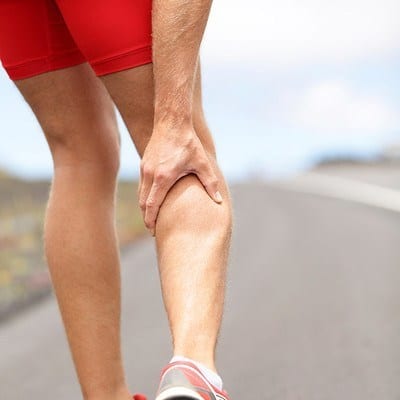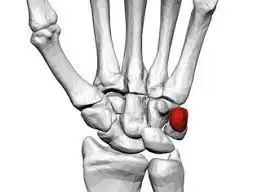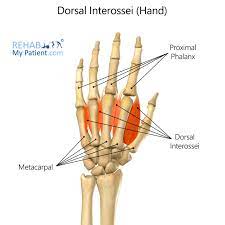Pulled calf muscle: Causes, risk factor, symptoms, diagnosis, Treatment, exercises
Table of Contents
What is a pulled calf muscle?
A pulled calf muscle, or a calf muscle strain, happens when the muscles in the calf — the soleus and gastrocnemius — get overstretched.
The calf muscles are in the lower leg behind the shin bone and extend from the base of the thigh down to the heel. They help flex and bend the foot, ankle, and knee. A calf strain can cause pain and put a stop to running, jumping, and doing other activities.
A particular pulled calf muscle can result in partial or complete tears. A torn calf muscle may require surgery.
Is strain like a sprain?
A calf strain isn’t a sprain. Strains mean injuries to muscles or tendons (tissues that attach muscles to bones). Sprains mean injuries to ligaments (tissue that connects bones or cartilages or holds a joint along.
Where is the calf muscle located?
The calf muscle contain two main muscles — the gastrocnemius muscle and additionally the soleus muscle. as a result of these two muscles closing more than the heel and fixing to the muscle, the gastrocnemius and soleus muscles are collectively big muscles with two sections.
In the inclusion of those two large muscles, a little muscle called the plantaris runs between the gastrocnemius and soleus muscle throughout the length of the lower leg. these 3 muscles are the triceps surae. however, not everyone consists a plantaris muscle. about 100 % of individuals solely have 2 larger muscles.
It is composed of 3 muscles:
Gastrocnemius muscle

gastrocnemius – in concurrence with soleus muscle, provides primarily plantar flexion of the knee joint and flexion at the ginglymoid joint. plantar flexion allows the knee joint force throughout gait. though its course over two joints, the gastrocnemius muscle isn’t able to exert its most power on each joint at the same time. If the knee is flexed, the gastrocnemius muscle cannot build most power at the ankle joint.
Origin: two heads are located from the medial & lateral condyle of the femur.
Insertion: Achilles tendon
Nerve: tibial nerve (S1 – S2) & cutaneous supply is mainly provided by L4, L5,&S2
Actions: plantar flexes foot, flexes knee
Antagonist: Tibialis anterior muscle
Soleus muscle
soleus – is found at a lower site the gastrocnemius within the superficial posterior compartment of the lower leg. It is main performance is part flexion of the ankle joint and assist the tibia on the calcaneus limiting forward sway.
Origin: Fibula, medial border of tibia (soleal line).
Insertion: Tendo calcaneus
Nerve: Tibial nerve L5 – S2
Actions: Plantar flexion
Antagonist:Tibialis anterior
Plantaris muscle
plantaris – is placed within the posterosuperficial compartment of the calf. Functionally, plantaris isn’t an important contributor and acts with gastrocnemius muscle as all a flexor muscle of the knee and a plantar flexor of the ankle joint.
Origin: Lateral supracondylar ridge of the femur above the lateral head of the gastrocnemius muscle
Insertion: Tendo calcaneus (medial aspect, deep to gastrocnemius muscle-tendon)
Nerve: tibial nerve from anterior rami of S1-S2
Actions: Plantar flexes the foot & flexes the knee
Antagonist: Tibialis anterior muscle
Who gets pulled calf muscles?
Anyone can obtain a pulled calf muscle. But these strains are more common in players who perform lots of stop-and-go movements with rapid bursts of speed. Sprinters, football players, soccer players, and tennis players are susceptible to pulled calf muscles. eventually, the injury is called “tennis leg.”
What is the causes of pulled calf muscles?
Calf muscle strains generally occur when someone suddenly moves or overstretches their calf after standing more time. Fast pivots, jumps, or abrupt stops can cause strains. This injury is mainly common when toes get forced upward (toward the body) and the ankle pulls calf muscles down too rapidly.
An acute calf muscle strain is once muscle tears rapidly and unexpectedly. muscle tears will happen either from injuries or trauma. this will result to:
• Not warming up correctly before physical activity
• deficient flexibility
• deficient conditioning
• Overexertion and fatigue
• calf muscle Weakness
Acute calf muscle strain: Slip body, jump, run, throw something, raise something heavy, lift something while clumsy position.
Chronic calf muscle strain: Sports like row, tennis, golf, or baseball, poor posture, holding back or neck in an ungainly position for long periods of time, like after work at a desk.
Overuse:
Repeating a similar movement, whether or not at work or during an associate activity like taking part in sports — will cause overuse syndrome.
Don’t stretch or warm up prior to exercise: Stretching prior to exercise step by step will increase how much stress you place on muscles.
A lack of flexibility: If you’re not much flexible, your calf muscles (and the fibers in them) are tighter, which build them additional susceptible to strains.
Other risk factors for pulled calf muscles include:
Age: People over 40 may be more likely to obtain strains during physical activity.
Sex: Men are more likely to get calf muscle injuries.
Lack of conditioning: It’s important to warm up and stretch prior to physical activity and condition muscles before the start of a sports season.
Muscle quality: individuals with tight or short calf muscles have more risk of calf strains.
The pulled Calf muscle is classified into three grades:
Grade 1: Grade 1 injury causes minimal muscle damage, although there may be sharp pain at the time of injury. May be able to continue an activity, without pain or with mild discomfort.
Average time to come back to sport:10-12 days
sign-pain on unilateral calf raise.
Grade 2: Grade 2 injuries cause moderate muscle damage, and people with this category of muscle injury may have difficulty walking. They will often experience a sharp pain that worsens when they flex or extend their foot.
Average time to come sport:16-21 damage days
sign-pain with active plantar flexion, pain and weakness with resisted plantar flexion, loss of flexion.
Grade 3:
A grade 3 injury is a complete tear of the muscle, and it can cause significant bruising and swelling in the calf.Full recovery can take three to four months and, in some instances, surgery may even be needed.
Average time to come sport: 6 months once surgery
sign-inability to contract calf muscle may have the palpable defect, & Thomson’s test positive
What are the symptoms of a pulled calf muscle?
• Difficulty tensing calf muscles or standing on toes.
• Muscle pain when flexing ankle or pointing toes.
• Problems bending knee.
• Snapping or popping sensation in calf.
• Sudden pain in the back of lower leg.
• Swelling in calf muscle.
• Bruising on calf muscle.
Most people with a pulled calf muscle report not being able to continue with their activity instantly following the injury.
Differential diagnosis:
- Medial leg bone stress syndrome
- Plantar fasciopathy
- Ankle Joint sprain
- Medial leg bone stress syndrome
- Leg injuries related to sports with same symptoms and treatment as a calf strain are mentioned below.
- Chronic exertional compartment syndrome (CECS)
- Achilles tendinopathy
- Popliteal Artery entrapment Syndrome (PAES)
Diagnosis and tests:
You may require imaging exams to find out if there are any partial or complete tears in calf muscles. These tests can also rule out other conditions that source lower leg pain, such as Achilles tendon ruptures or deep vein thrombosis (DVT).
- Ultrasound, to examine for tears or fluid buildup around the calf muscles.
- MRI, to examine for blood clots, a tear, or internal bleeding.
Assessment
Subjective assessment
- history with associated symptoms
- mechanism of injury:
- Inciting trauma- side and magnitude of injury force
- recurrent trauma-faulty postural related injuries
Objective assessment
- Examine the foot and ankle in supine and standing position
- Ankle Active range of motion
- Ankle Passive range of motion
- Resisted strength check the ankle and foot
- Knee Active ROM and manual muscle testing
On objective assessment, there will be:
- muscle Tenderness- to touch at the point of injury
- Swelling
- Bruising may appear within hours or days
- Stretching of the muscle will reproduce pain
- Pain on resisted plantar flexion.
Treatment
Medical Treatment
Pulled calf muscle infrequently need surgery still may be necessary for a complete rupture.
Pain reliving medicine mostly Non-Steroidal Anti-Inflammatory Drugs (NSAIDs) — during the first 48 hours after a muscle strain. Acetaminophen (Tylenol) and others can be helpful for pain relief during this period.
A physiotherapist can assist to increase the strength and stability of the injured joint or limb. The stabilize the calf with a brace or splint. For few calf muscle inJuries, or some calf muscle sprint surgery may be called.
For immediate relief you can use RICE Principle:
- R- rest
- I- ice for cooling
- C- compression: tapping and splinting
- E- elevation
the R.I.C.E approach
Rest: Refused some activities that cause pain, swelling, or discomfort. don’t avoid all physical activity.

Ice: Ice is a tried-and-true tool for decrease pain and swelling. Apply an ice pack (covered with a light, absorbent towel to help prevent frostbite) for 15-20 minutes every 2 to 3 hours during the first 24 to 48 hours after injury.
Compression: This means wrapping the injured part to prevent swelling. Wrap the affected part with an elastic medical bandage. You should to be snug but not too tight.if it’s too tight, it’ll interrupt blood flow. If the skin under the wrap turns blue or feels cold,numb, or tingly, loosen the bandage. If these symptoms don’t disappear right away, seek instantly medical help.
Elevation: Elevate the leg on high of your heart’s extent, importantly at night time, that allows gravity to help reduce swelling.
Physiotherapy treatment:
The goal of physiotherapy treatment are:
Relieve calf muscle pain
Reduce muscle swelling
Increases calf muscle strengths.
restore patient’s confidence
restore patients’ full functional activities
increase full mobility of the ligament and corresponding joint
Electrotherapy treatment
physiotherapy rehabilitation can be begin after 48 hours of injury, For the first few days give electric modality give to reduce swelling and pain.
Ultrasound
ultrasound has been used about tissue healing increases blood circulation and mobility & reduce swelling.
Cryotherapy
Inflammation and swelling can be decrease by applying cryotherapy in form of ice packs, and cold water baths to the affected part. Constant application of cold several times a day for 15-30 minutes at a time is suggest.
TENS
Trans cutaneous electrical nerve stimulation (TENS) may be able to help decrease pain and muscle spasms.
Pulled calf muscle rehabilitation exercises:
Phase one- the 1st week after injury
ice application , 3 times par day
compression
isometric exercise: heel press
Phase two- the 2nd and 3rd weeks after injury
ice appliance 15-20 min, after exercise
start active ROM exercises,
rest from painful activities.
range of motion exercise: knee flexion exercise
knee extension
plantar flexion
dorsiflexion
genital calf resisted exercise
stretching exercises
Phase three-3 to 4 weeks after injury
gentle strengthening exercises:
knee flexion
knee extension
plantar flexion
dorsiflexion
genital pain-free calf stretching:
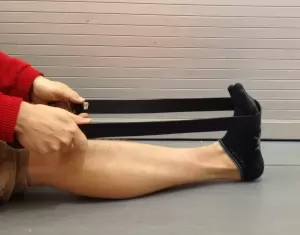
You can start gently stretching calf muscle:
1.Towel stretch:
Sit on a firm surface with one leg stretched ahead of you. Loop towel circling toes and the of foot and pull the towel toward body keeping knee straight. now hold this position for 15 to 30 seconds and then relax. Repeat 3 times.
2.Seated heel Raises:
Sit on a chair with both legs on the ground. Pressing down through the toes, raise heels off the floor.
Hold this position for ten seconds.Repeat 10 times.
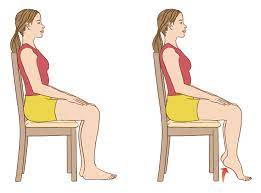
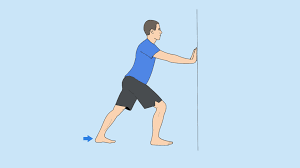
3.Standing calf stretch:
Stand near a wall with 1 foot in front of the other, front knee slightly bent.Keep your back knee straight, your heel on the ground, and lean toward the wall. Feel the stretch all along the calf of your back leg. Hold this stretch for 15-20 seconds. Switch legs, then alternate for a total of 3 repetitions.
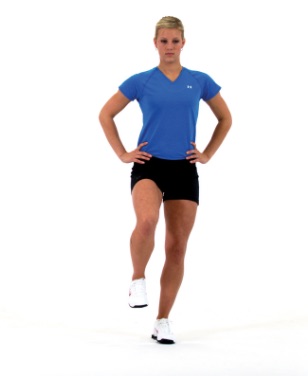
Do this exercises afterwards you’ll stand on your toes while not in the pain:
1.Single leg balance:
Stand with no support and arrange to maintain on one leg.
Repeat three times.
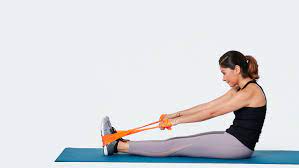
2.Resistance Band Calf Exercise:
Wrap the band around the end of your foot and pushing down into the band, extending your toes and engaging the calf.Hold this position for three seconds, then slowly relax to the starting position. Perform 10 to 15 repetitions. Switch legs and repeat.
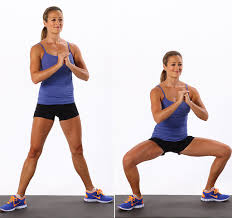
3.Full squat:
Your hips go down below your knees.
Perform 10 to 15 repetition
4.wall jump:
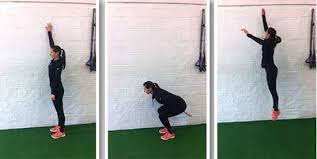
you have to face a wall and site a piece of masking tape regarding a pair of feet higher than your head. Afterwards that jump up together with your arms higher than your head and take a look at the touch of there piece of tape. check that you are doing -a “spring” variety of movement and don’t land hard on your feet. enhance to taking off and landing on. A single foot. Do three sets of ten.
Preventive measures:
- perform daily stretching and strengthening exercises for your sports, fitness, or work external, as a part of an overall physical activities.
- An exercise protocol can help to decrease your danger of muscle strains.
- Try to be in a shape to play sport; do not play sport to get in shape.
- your physically required occupation, regular exercise can not to injuries.
- do regular diet and an exercise program to balance a healthy weight. The overweight can put down pressure on the muscles, making muscle strains again expected to do.
- Walk at a maximum pace for 3 to 5 minutes prior doing any sports or a variant physical activity.
- Going this will warm up your muscles and prepare them for an maximize in the intensity of the exercise.

